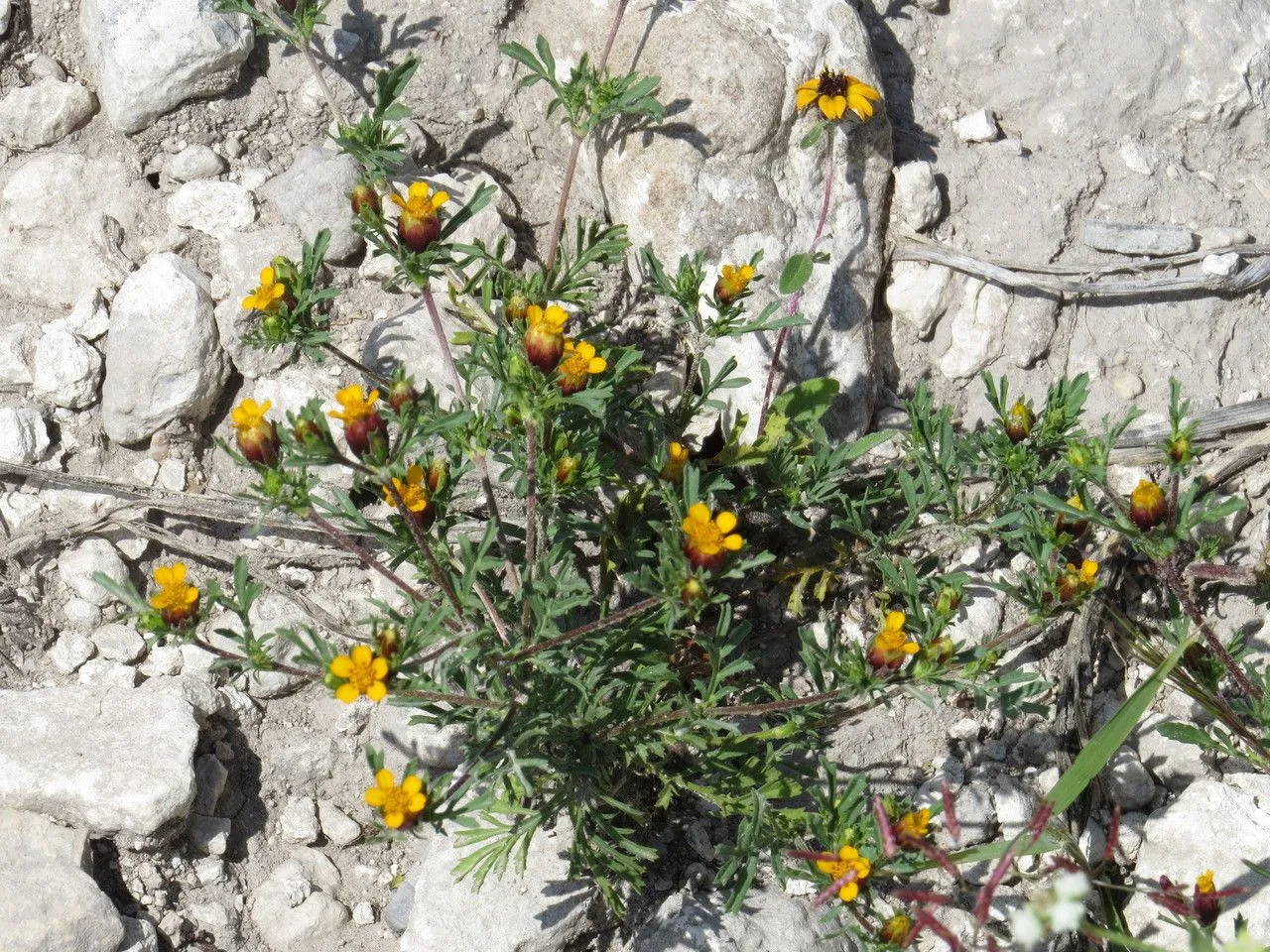
Author: (Vent.) Hitchc.
Bibliography: Trans. Acad. Sci. St. Louis 5(3): 503 (1891)
Year: 1891
Status: accepted
Rank: species
Genus: Dyssodia
Vegetable: False
Observations: E. Canada to Guatemala, Bolivia to NW. Argentina
Fetid-marigold, known scientifically as Dyssodia papposa, is a fascinating and distinctive member of the Asteraceae family. Remarked upon in the “Transactions of the Academy of Science of St. Louis” (Volume 5, Issue 3, page 503) by Ventenat and later acknowledged by Hitchcock, this plant has a rich history documented since 1891.
This annual herbaceous plant is native to a broad range extending from Eastern Canada through to Guatemala and spanning down to Bolivia and Northwestern Argentina. This wide geographical distribution speaks to its adaptability and ecological versatility.
Characterized by its strong, often pungent scent, Fetid-marigold can often be recognized before even being seen. Its aroma, which some find unpleasant, is a natural deterrent to herbivores, proving beneficial for its survival. The etymology of “fetid” in its common name aptly describes this notable characteristic.
Dyssodia papposa typically thrives in open, sunny habitats and can often be found in disturbed soils, roadsides, and grasslands, where it can grow somewhat freely. The plant features finely divided, almost feathery leaves that contribute to its distinctive visual profile. When in bloom, it presents small, bright yellow flower heads that are characteristic of the Asteraceae family, forming a subtle but striking display.
In addition to its ecological role, Fetid-marigold has been used in traditional practices, although its potent smell often limits its appeal for broader horticultural or ornamental use. Nonetheless, its presence across such a vast territory indicates its resilience and ecological importance as a species.
In summary, Dyssodia papposa, or Fetid-marigold, is a notable plant within the Asteraceae family due to its distinctive smell, wide distribution, and adaptability to various environments. First described in scientific literature in 1891, it continues to intrigue botanists and plant enthusiasts with its unique characteristics and widespread habitat.
Eng: dogbane dyssodia, dogweed, fetid dogweed, fetid marigold, fetid-marigold, prairie dogweed, stinking-marigold, foetid marigold, stinking marigold
Fra: dyssodie à aigrette
En: Fetid-marigold, Stinking-marigold, Fetid marigold, PRAIRIE DOGWEED, Dogbane dyssodia, Fetid dogweed, Dogweed, Foetid marigold, Stinking marigold
Fr: Dyssodie à aigrette
Taken Oct 14, 2014 by EOL − Alfredo Eloisa (cc-by-nc)
Taken Mar 9, 2015 by EOL − Richard Spellenberg (cc-by-nc-sa)
Taken Oct 14, 2014 by EOL − Alfredo Eloisa (cc-by-nc)
Taken Mar 9, 2015 by EOL − Richard Spellenberg (cc-by-nc-sa)
Taken Oct 12, 2020 by B Kari (cc-by-sa)
Taken Nov 6, 2014 by EOL − Leticia Soriano Flores (cc-by-nc)
Taken Oct 24, 2014 by EOL − promotores_atotonilco (cc-by-nc)
Taken Nov 22, 2015 by EOL − Efren Trejo (cc-by-nc)
Taken Nov 22, 2015 by EOL − Efren Trejo (cc-by-nc)
Taken Mar 9, 2015 by EOL − Richard Spellenberg (cc-by-nc-sa)
© copyright of the Board of Trustees of the Royal Botanic Gardens, Kew.
© copyright of the Board of Trustees of the Royal Botanic Gardens, Kew.
© copyright of the Board of Trustees of the Royal Botanic Gardens, Kew.
Growth habit>: Forb/herb
Family: Myrtaceae Author: (F.Muell.) K.D.Hill & L.A.S.Johnson Bibliography: Telopea 6: 402 (1995) Year: 1995 Status:…
Family: Rubiaceae Author: Pierre ex A.Froehner Bibliography: Notizbl. Bot. Gart. Berlin-Dahlem 1: 237 (1897) Year:…
Family: Sapindaceae Author: Koidz. Bibliography: J. Coll. Sci. Imp. Univ. Tokyo 32(1): 38 (1911) Year:…
Family: Asteraceae Author: A.Gray Bibliography: Pacif. Railr. Rep.: 107 (1857) Year: 1857 Status: accepted Rank:…
Family: Fabaceae Author: Medik. Bibliography: Vorles. Churpfälz. Phys.-Ökon. Ges. 2: 398 (1787) Year: 1787 Status:…
Family: Aspleniaceae Author: (Cav.) Alston Bibliography: Bull. Misc. Inform. Kew 1932: 309 (1932) Year: 1932…